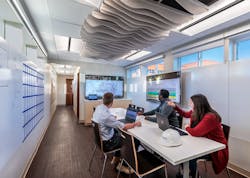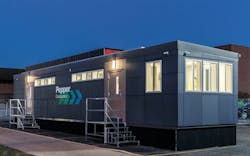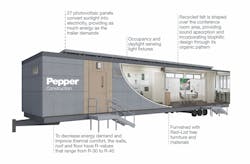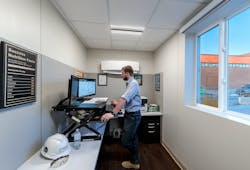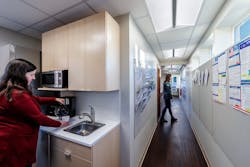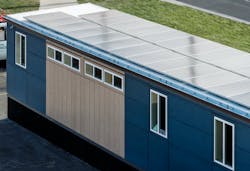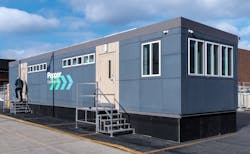Net zero construction trailer brings health and wellness to the jobsite
The AEC industry has gone all in on sustainability, energy efficiency, and occupant health and wellness. These elements are woven into the fabric of just about every new building, including AEC firms’ own offices.
However, there’s one critical workspace that remains an afterthought when it comes to sustainability, health, wellness, and productivity: the jobsite trailer.
Chicago-based Pepper Construction has a plan to bring its jobsites up to speed. In November, at the Greenbuild show, the contractor unveiled its Net Zero Jobsite Trailer. The 12x60-foot structure is designed to focus on the human experience, productivity, and quality from every aspect to make sure employees in the field have the same wellness features as those in a traditional office setting.
See Also: A modular, scalable mobile hospital can quickly respond to natural disasters and crises
“Most people spend about 90% of their time indoors, and that environment has a significant impact on our health,” says Susan Heinking, AIA, LEED Fellow, Pepper’s VP of High Performance and Sustainable Construction, who led the project. “That philosophy also applies to the men and women working on our jobsites. We want our trailer to match our values.”
The trailer’s exterior is clad in cement fiber panels and illuminated with daylight-sensing light fixtures. Photo: ©2018 Ballogg Photography
A traditional jobsite construction trailer emits 53,712 lb of CO2 emissions into the air each year, making its carbon footprint equivalent to the energy use of four residential homes. The Net Zero Trailer is designed to greatly minimize its overall energy use, which is then offset with rooftop photovoltaic panels.
Cement fiber panels clad the trailer and reduce heat absorption. Six inches of rigid insulation increase energy efficiency, eliminate temperature swings, and double the R-values for the walls, floor, and roof, which range from R-30 to R-40. On the roof, three strings of nine commercial solar panels convert four hours of sunlight into the energy needed to power the trailer for a full work day.
Double-pane, low-argon windows are fitted with transparent shades for glare control and are operable to provide fresh air. Natural light pours in through these windows, greatly reducing the need for lighting. When artificial lighting is necessary, a wireless low-consumption system with integrated occupancy and daylight sensors activates.
The trailer features a meeting room that can hold up to 14 people and hoteling space for visitors. Above the meeting room is recycled, bio-formed felt that provides sound absorption. The flexible workspace includes stand-up desks, folding Red List-free furniture, and storage lockers. A full-amenity kitchen, equipped with appliances and fixtures, is included to eliminate restrictions on occupant diets.
